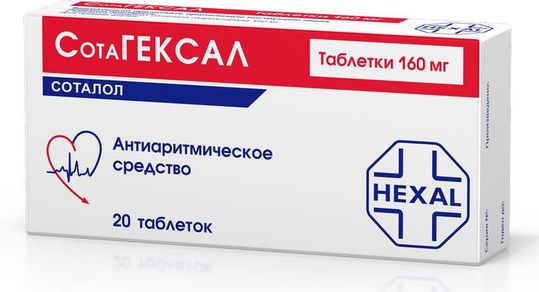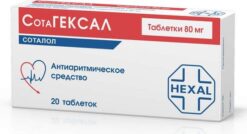No products in the cart.
Sotagexal, tablets 160 mg 20 pcs
€4.55 €4.04
Description
Pharmgroup:
The beta-adrenoblocker.
Pharmic action:
SotaHexal is a beta1-, beta2-adrenoblocker. Sotalol is a non-selective β1-, β2-adrenoreceptor blocker with no sympathomimetic or membrane-stabilizing activity of its own. Like other beta-adrenoblockers, sotalol suppresses renin secretion, and this effect is pronounced both at rest and during exercise.
The beta-adrenoblocking effect of the drug causes a decrease in heart rate (negative chronotropic effect) and a limited decrease in heart force (negative inotropic effect). These changes in cardiac function reduce myocardial oxygen demand and cardiac workload.
The antiarrhythmic properties of sotalol are associated with both blockade of β-adrenoreceptors and prolongation of myocardial action potential. The main effect of sotalol is to increase the duration of effective refractory periods in atrial, ventricular and accessory pulse conduction pathways.
Pharmacokinetics:
Intake
Bioavailability when taken orally is almost complete (over 90%). Cmax in plasma is reached 2.5-4 hours after oral administration. Absorption is reduced by approximately 20% with food compared to fasting. In the dose range from 40 to 640 mg/day the plasma concentration of Sotalol is proportional to the dose taken.
Distribution
Distribution occurs in the plasma and in peripheral organs and tissues. Css is reached within 2-3 days. Sotalol does not bind to plasma proteins.
Passes poorly through the BET, with its concentration in cerebrospinal fluid being only 10% of that in plasma.
Metabolism
Not metabolized. The pharmacokinetics of the d- and l-enantiomers of sotalol are almost identical.
Excretion
The main route of excretion from the body is excretion through the kidneys. From 80 to 90% of the administered dose is excreted unchanged in the urine, and the rest in the feces. T1/2 is 10-20 h.
Pharmacokinetics in special clinical cases
Patients with impaired renal function should be prescribed lower doses of the drug.
The pharmacokinetics do not change much with age, although impaired renal function in elderly patients reduces the excretion rate, which leads to increased accumulation of the drug in the body.
Indications
Indications
Symptomatic and chronic cardiac rhythm disorders:
– Ventricular tachycardia, including supraventricular tachycardia in Wolf-Parkinson-White syndrome;
– ventricular extrasystole;
– paroxysmal atrial fibrillation.
Active ingredient
Active ingredient
Composition
Composition
1 tablet contains sotalol hydrochloride 160 mg.
How to take, the dosage
How to take, the dosage
SotaGEXAL is taken orally before meals, without chewing, with plenty of fluid, 80-120 mg/day in 2-3 doses.
In case of insufficient effectiveness, up to 160-240-320 mg/day in 2-3 doses.
In severe arrhythmias – up to 480 mg/day in 2-3 doses. The dose should be increased at 2-3 day intervals.
Interaction
Interaction
Concomitant administration of slow calcium channel blockers such as verapamil and diltiazem may decrease BP as a result of impaired contractility. The intravenous administration of these drugs against the background of Sotalol use should be avoided (except in cases of emergency medicine).
The combined use of Class I A antiarrhythmic agents (especially quinidine type: disopyramide, quinidine, procainamide) or Class III (e.g., amiodarone) may cause marked prolongation of the QT interval. Drugs that prolong the QT interval should be used with caution with drugs that prolong the QT interval, such as class I antiarrhythmic agents, phenothiazines, tricyclic antidepressants, terfenadine and astemizole, and some quinolone-type antibiotics.
Concomitant administration of nifedipine and other 1,4-dihydropyridine derivatives may decrease BP.
Concomitant administration of noradrenaline or MAO inhibitors, as well as abrupt withdrawal of clonidine may cause arterial hypertension. In this case, withdrawal of clonidine should be done gradually and only a few days after the end of Sotagexal.
Tricyclic antidepressants, barbiturates, phenothiazines, opioid and antihypertensive agents, diuretics and vasodilators may cause a sharp decrease in BP.
The use of agents for inhalation anesthesia, including tubocurarine while taking Sotagexal increases the risk of inhibition of myocardial function and development of arterial hypotension.
The concomitant use of Sotagexal with reserpine, clonidine, alpha-methyldopa, guanfacine and cardiac glycosides may cause marked bradycardia and delay excitation in the heart.
Beta-adrenoblockers may potentiate arterial withdrawal hypertension following discontinuation of clonidine, so beta-adrenoblockers should be withdrawn gradually, several days before clonidine is phased out.
Administration of insulin or other oral hypoglycemic agents, especially during physical activity, may lead to increased hypoglycemia and manifestation of its symptoms (increased sweating, rapid pulse, tremor). With diabetes it is necessary to adjust the doses of insulin and/or hypoglycemic drugs.
Potassium withdrawing diuretics (e.g., furosemide, hydrochlorothiazide) may provoke the occurrence of arrhythmias caused by hypokalemia.
When used concomitantly with Sotagexal, higher doses of beta-adrenomimetics such as salbutamol, terbutaline, and isoprenaline may be required.
Special Instructions
Special Instructions
Caution should be exercised when prescribing Sotagexal to patients:
– with a history of diabetes mellitus with marked fluctuations in blood glucose levels, as well as with strict diets;
– In pheochromocytoma (simultaneous administration of alpha-adrenoblockers is required);
– In the history or family history of psoriasis;
– In renal dysfunction;
– The elderly.
The drug is administered under the control of HR, blood pressure and ECG. In case of marked BP lowering or heart rate slowing down, the daily dose should be reduced.
Patients with impaired renal function require dosage adjustment.
Discontinuation of Sotagexal should be supervised by a physician and should be done gradually (especially after long-term use).
Sotagexal should not be used in patients with hypokalemia or hypomagnesemia until the abnormalities have been corrected. These conditions may increase the degree of QT interval prolongation and increase the probability of “pirouette” arrhythmia. It is necessary to control electrolyte balance and acid-base status in patients with severe or prolonged diarrhea and in patients receiving drugs which cause decrease of magnesium and/or potassium in organism.
In thyrotoxicosis, sotalol may mask certain clinical signs of thyrotoxicosis (e.g., tachycardia). Abrupt withdrawal in patients with thyrotoxicosis is contraindicated because it can exacerbate the symptoms of the disease.
We should be careful when prescribing beta-adrenoblockers to patients who are on hypoglycemic medications, because hypoglycemia may occur during prolonged interruptions of food intake, and symptoms such as tachycardia or tremor may be masked by the drug action.
Contraindications
Contraindications
Hypersensitivity (including. to sulfonamides), chronic heart failure stage II-III, shock, AV block of II-III degree, sinoatrial block, sinus node weakness syndrome, bradycardia, QT interval prolongation, hypokalemia, hypotension, Severe peripheral circulatory disorders, obstructive airways disease (including bronchial asthma), metabolic acidosis, laryngeal edema, myasthenia gravis, severe allergic rhinitis.
Side effects
Side effects
Nervous system and sensory organs: dizziness, headache, feeling of fatigue, sleep disturbance, confusion, paresthesia, depression. Corneal and conjunctival inflammation (should be considered when wearing contact lenses), visual impairment (extremely rare), decreased tear production.
Cardiovascular system and blood (hematopoiesis, hemostasis): heart failure, bradycardia, AV blockade, angina pectoris (in rare cases), hypotension.
Respiratory system: bronchospasm.
Gastrointestinal system disorders: nausea, diarrhea, constipation, dry mouth.
Metabolic disorders: hypoglycemia (more often in diabetic patients or when strictly following the diet).
Urinary system disorders: decreased potency.
Musculoskeletal disorders: feeling of coldness in the extremities, muscle weakness or cramps.
Skin disorders: skin rash, itching (rare); redness, psoriasiform dermatosis, alopecia.
Overdose
Overdose
Symptoms: BP decrease, bradycardia, bronchospasm, hypoglycemia, loss of consciousness, generalized seizures, ventricular tachycardia; in severe cases – symptoms of cardiogenic shock, asystole.
Treatment: gastric lavage, hemodialysis, prescription of activated charcoal. Symptomatic therapy: atropine 1-2 times by IV fluids; glucagon – first as a brief IV infusion at a dose of 0.2 mg/kg body weight, then – at a dose of 0.5 mg/kg body weight by IV infusion for 12 hours.
Similarities
Similarities
Additional information
| Weight | 0.015 kg |
|---|---|
| Conditions of storage | In a light-protected place at a temperature not exceeding 25 °C. |
| Manufacturer | Salutas Pharma GmbH, Germany |
| Medication form | pills |
| Brand | Salutas Pharma GmbH |
Other forms…
Related products
Buy Sotagexal, tablets 160 mg 20 pcs with delivery to USA, UK, Europe and over 120 other countries.
















